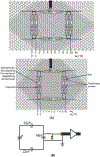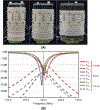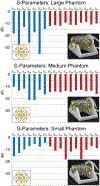Size-adaptable "Trellis" structure for tailored MRI coil arrays
- PMID: 30575119
- PMCID: PMC6484426
- DOI: 10.1002/mrm.27637
Size-adaptable "Trellis" structure for tailored MRI coil arrays
Abstract
Purpose: We present a novel, geometrically adjustable, receive coil array whose diameter can be tailored to the subject in order to maximize sensitivity for a range of body sizes.
Theory and methods: A key mechanical feature of the size-adaptable receive array is its trellis structure that was motivated by similar structures found in gardening and fencing. Our implementation is a cylindrical trellis that features encircling, diagonally interleaved slats, which are linked together at intersecting points. The ensemble allows expansion or contraction to be controlled with the angle between the slats. This mechanical frame provides a base for radiofrequency coils wherein approximately constant overlap, and therefore coupling between adjacent elements, is maintained when the trellis is expanded or contracted. We demonstrate 2 trellis coil concepts for imaging lower extremity at 3T: a single-row 8-channel array built on a trellis support structure and a multirow 24-channel array in which the coil elements themselves form the trellis structure.
Results: We show that the adjustable trellis array can accommodate a range of subject sizes with robust signal-to-noise ratio, loading, and coupling.
Conclusion: The trellis coil concept enables an array of surface coils to expand and contract with negligible effect on tuning, matching, and decoupling. This allows an encircling array to conform closely to anatomy of various sizes, which provides significant gains in signal-to-noise ratio.
Keywords: coupling; phased-array; preamplifier noise; stretchable; trellis.
© 2018 International Society for Magnetic Resonance in Medicine.
Figures









References
-
- Roemer PB, Edelstein WA, Hayes CE, Souza SP, Mueller OM. The NMR phased array. Magn Reson Med 1990;16:192–225. - PubMed
-
- Sodickson DK, Manning WJ. Simultaneous acquisition of spatial harmonics (SMASH): fast imaging with radiofrequency coil arrays. Magn Reson Med 1997;38:591–603. - PubMed
-
- Pruessmann KP, Weiger M, Scheidegger MB, Boesiger P. SENSE: sensitivity encoding for fast MRI. Magn Reson Med 1999;42:952–962. - PubMed
-
- Griswold MA, Jakob PM, Heidemann RM, et al. Generalized autocalibrating partially parallel acquisitions (GRAPPA). Magn Reson Med 2002;47:1202–1210. - PubMed
Publication types
MeSH terms
Grants and funding
LinkOut - more resources
Full Text Sources
Medical

